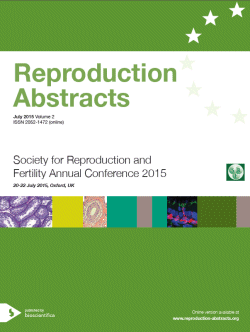
Society for Reproduction and Fertility Annual Conference 2015
Oxford,
UK
20 Jul 2015 - 22 Jul 2015

ORAL COMMUNICATIONS
Oral Communications 4: Female reproduction
ra0002o025 | Oral Communications 4: Female reproduction | SRF2015
Alteration of mechanisms underlying pituitary microvasculature remodelling and reduction in prolactin secretion precede full activation of the gonadotrophic axis in anoestrous ewes receiving exogenous melatonin
Mooney Josephine , Ferreira Catarina Fernandes , Castle-Miller Jennifer , Bates David O , Clarke Iain , Tortonese Domingo
ra0002o026 | Oral Communications 4: Female reproduction | SRF2015
Neuroendocrine control of ovulation in primates: a role for two distinct populations of GnRH neurons?
Urbanski Henryk F , Loza Alejandra Marquez , Brown Donald I
ra0002o027 | Oral Communications 4: Female reproduction | SRF2015
Investigation into the role of endometrial heparinase, hypoxia-inducible factor 1A, secreted phosphoprotein 1, uteroferrin, and vascular endothelial growth factor A in foetal growth in pigs
Stenhouse Claire , Hogg Charis O , Donadeu Francesc X , Ashworth Cheryl J
ra0002o028 | Oral Communications 4: Female reproduction | SRF2015
Regulation of the prostaglandin synthase COX2 by epidermal growth factor requires steroid receptor coactivator interacting protein in human myometrium
Hudson Claire A , Heesom Kate J , Bernal Andres Lopez
ra0002o029 | Oral Communications 4: Female reproduction | SRF2015
Maternal leptin levels: association with pregnancy outcome
Tennekoon Kamani Hemamala , Sugathadasa Rohan , Karunanayake Eric Hamilton , Kumarasirir Jayalath , Wijesundera Ajita



